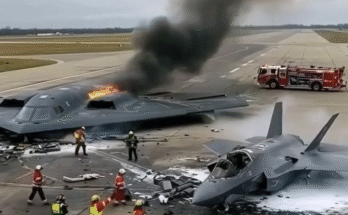A City in Mourning: In-Depth Analysis of the UPS Flight 2976 Louisville Catastrophe That Shook the Nation (≈1,000 words)
On the evening of November 4, 2025, what began as a routine cargo departure out of Louisville Muhammad Ali International Airport turned into one of the worst aviation disasters to touch the city in recent memory. UPS Flight 2976 — an MD-11 bound for Honolulu — crashed shortly after takeoff, tearing through a nearby industrial area and igniting a massive, fast-moving blaze. The human toll grew over the following days as recovery teams worked through wreckage and smoke, and the region was left grappling with grief, disruption, and urgent questions about aviation safety and community resilience. (Wikipedia)
What happened (preliminary facts)
Early reports and NTSB statements indicate the aircraft lost its left engine during the takeoff roll; by the time it lifted off, the left wing was already ablaze and the jet quickly entered an unrecoverable left bank before impacting structures off airport property. Videos captured by bystanders showed flames trailing the airplane seconds before impact, and investigators recovered both the cockpit voice recorder and flight data recorder. Officials confirmed multiple fatalities — including all three crewmembers aboard — and numerous injuries on the ground as fires spread to nearby warehouses and fuel storage. (NTSB)
Immediate emergency response and search-and-rescue
Louisville’s first responders were on scene within minutes. More than 100 firefighters battled the blaze, while paramedics, police, and federal investigators secured the area and established reunification and triage centers. Hospitals declared mass-casualty responses and treatment lines were overwhelmed with patients suffering burns and smoke inhalation. Authorities issued shelter-in-place alerts for surrounding neighborhoods as airborne particulates and active fires created a hazardous environment. The rapid multi-agency mobilization saved lives, but the scale and ferocity of the inferno hindered early rescue efforts. (Reuters)
Human cost and community trauma
Beyond the statistics, the crash flattened lives: workers at nearby facilities, residents in the industrial corridor, and first responders all felt the immediate effects. Local vigils and spontaneous memorials sprang up in the days after the crash, while the mayor and governor declared the region in mourning. For a city where UPS’s Worldport hub is a major employer and civic pillar, the disaster was not only a human tragedy but an economic and psychological shock — neighbors who once saw the planes as a background noise now faced the trauma of lost colleagues, friends, and family. (CBS News)
Technical lines of inquiry: engine separation and structural history
Investigators have focused early attention on how an MD-11 could continue its takeoff with an entire engine detached. Preliminary NTSB material-stability checks and FAA records disclosed that the particular airframe had undergone recent repairs and had a recorded structural issue in the center wing fuel tank that previously required work — details that inevitably provoke scrutiny about maintenance, repair oversight, and record-keeping. The fact that the plane was fueled for a transoceanic flight — carrying a very large quantity of jet fuel — magnified the catastrophe when the wreck struck fuel tanks on the ground, producing an enormous fire. The NTSB has the technical lead; its final conclusions will take months to years and will be based on metallurgical tests, maintenance logs, FDR/CVR analysis, and component forensics. (The Guardian)
Environmental and public-health implications
The crash released thousands of gallons of jet fuel and created a long, intense conflagration that generated dense smoke and contaminants. Federal and state environmental agencies quickly mobilized to monitor air quality and potential soil or groundwater contamination — with EPA teams documenting the incident response. Short-term public-health actions (shelter-in-place orders, school closures, and advisories for those with respiratory vulnerabilities) were necessary; long-term environmental remediation may be required depending on findings about fuel dispersal and chemical residues at impacted industrial sites. (Environmental Protection Agency)
Economic ripple effects: UPS, the hub, and supply chains
Louisville’s economy is closely tied to UPS; the company’s Worldport is a logistics linchpin for same-day and overnight deliveries nationwide. In the immediate aftermath UPS suspended operations at the hub and several major customers warned of potential delivery delays. Beyond direct payroll impacts and the tragic human loss among employees, there are cascading effects: local suppliers, trucking partners, and national retail partners could face disruptions in the holiday season. The financial, reputational, and operational fallout will command strategic recovery planning from UPS and governmental economic relief for affected workers and businesses. (Wikipedia)
Regulatory and industry implications
When the NTSB issues its final report, potential recommendations may touch maintenance protocols, inspection frequency, repair approvals, communications during emergencies, and aircraft-type suitability for certain operations. If metallurgical defects, maintenance lapses, or design vulnerabilities are identified, the FAA could mandate inspections or airworthiness directives affecting MD-11 operators worldwide. The event is likely to prompt renewed scrutiny of aging freighter fleets, third-party maintenance operations, and how carriers document compliance with safety directives — particularly for aircraft performing long-haul, high-fuel-load missions. (NTSB)
Questions of legal liability and compensation
Families of victims and property owners affected by the crash will seek answers and accountability. Civil litigation could address wrongful death, property damage, and environmental remediation costs. Meanwhile, insurers and UPS will navigate claims for business interruption and reconstruction. If investigators find maintenance or manufacturer defects, legal remedies could expand beyond carrier liability. The interplay of federal investigative findings and private litigation will unfold over years. (People.com)
Pathways to healing and rebuilding
Recovery will require time and coordinated action: grief counseling and community support; transparent investigations that restore public trust; environmental remediation where needed; and economic support for displaced workers. The outpouring of community aid — volunteers, Teamsters and unions organizing vigils and support — highlights local resilience, but official support from federal, state, and corporate actors will be necessary to rebuild both materially and emotionally. (The Guardian)
Conclusion
UPS Flight 2976’s crash is a tragic intersection of human loss, industrial risk, and systemic questions about aviation safety in an era when aging fleets and high-tempo logistics operations coexist. The NTSB’s technical work will ultimately determine cause and recommend safeguards, but in the short term Louisville must focus on mourning, support for victims’ families, and restoring public safety. This catastrophe reminds the nation that complex supply chains and the aircraft that serve them operate within communities — and when technical failure occurs, its consequences are heartbreakingly, inescapably local. (NTSB)
If you’d like, I can expand this into a print-style longform piece with survivor interviews, a timeline (minute-by-minute reconstruction), or a technical explainer on MD-11 systems and engine mounts — or compile and attach source documents (NTSB updates, UPS statements, EPA advisories) for reference. Which would help you most?


